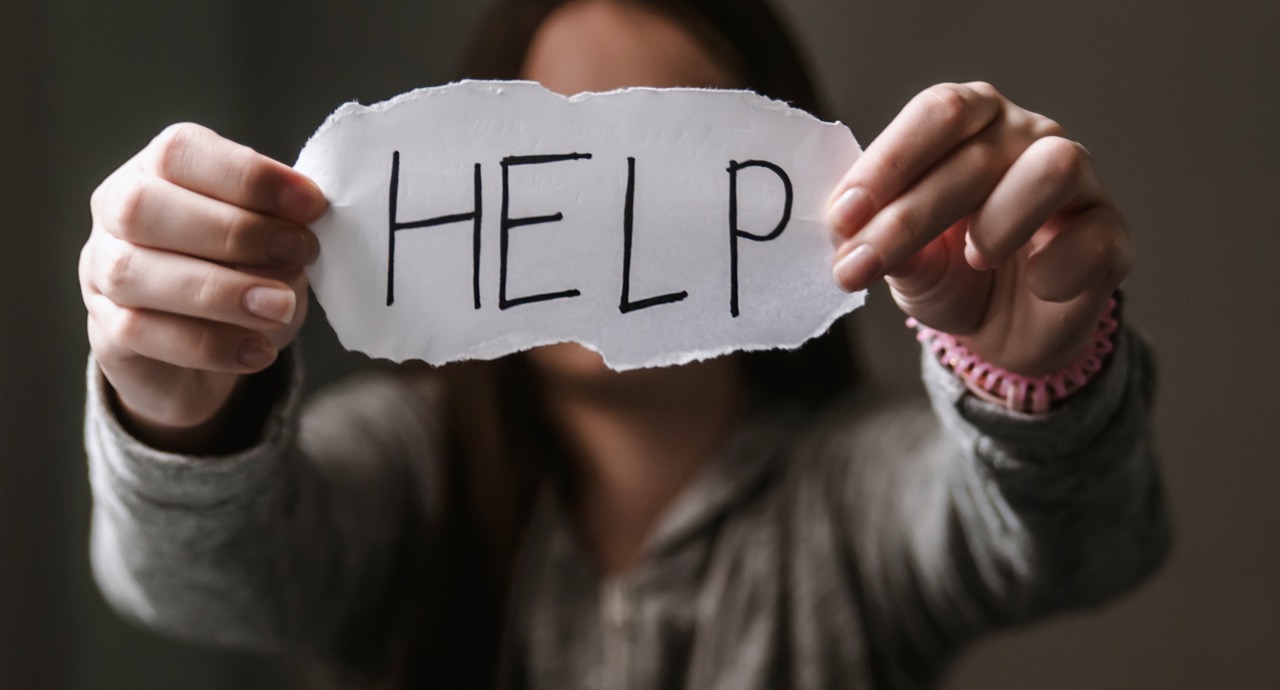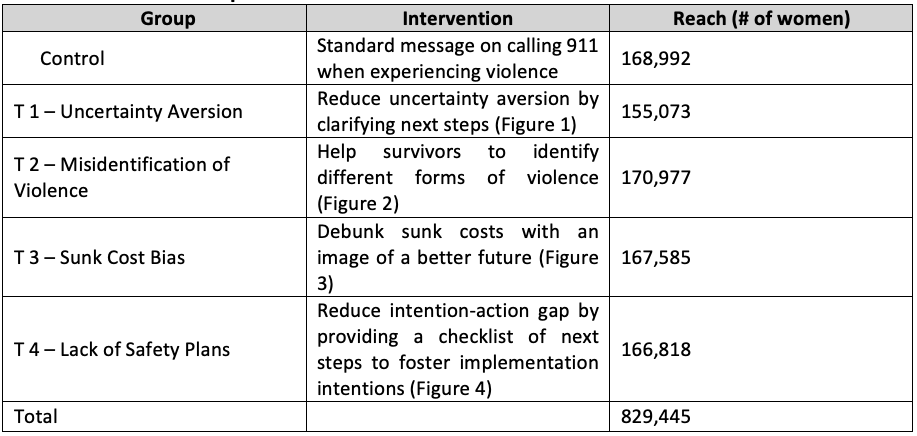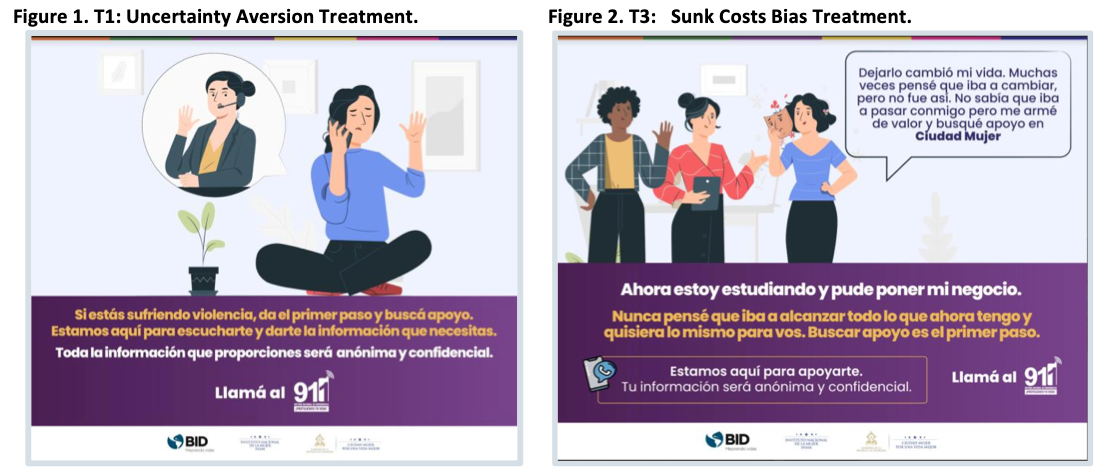Encouraging survivors of violence against women to seek help

Context
Over a quarter of all women in Honduras aged between 15 and 49 have experienced at least one act of physical violence. Over a fifth have experienced violence from their partner in a relationship during the last year. Yet, only a small share of those women have sought institutional support by the police, courts, or women's organizations. Violence against women (VAW) is even more pronounced during times of crisis and economic hardship, as we are currently experiencing with Covid-19. Additionally, the imperative of isolation and social distancing has strongly limited survivors' opportunities to seek outside help. Both institutional resources and social support network of friends and family are harder to access. Together, these factors show the importance of investigating how to best support survivors to access institutionalized help.
The Project
This project tested the effectiveness of different behaviorally-informed Facebook ads on women’s likelihood to seek information about support services, and to seek help in cases of violence against women. A multi-arm individually randomized controlled trial (RCT) was conducted on Facebook in collaboration with the Behavioral Insights Team (BIT), the National Institute for Women (INAM), and Ciudad Mujer in Honduras in Fall 2020. Ciudad Mujer is a one-stop facility offering multiple services to
Behavioral Analysis
Behavioral Barriers
Uncertainty Aversion: Uncertainty Aversion is a bias that describes a preference for known risks over unknown risks. This manifests itself in different aspects of individual decision-making, such as accessing public health services (reducing our motivations to seek health procedures) or financial decisions (reducing our willingness to take financial risks). Women in violent situations are particularly susceptible to this bias when making the mental leap between the intention to seek help and the action of seeking it, and they face a very high level of uncertainty.
Availability heuristic: Individuals judge the probability of a future event occurring based on the ease with which an occurrence of such an event comes to mind. For example, women might not classify emotional or financial abuse as a form of violence because the available mental representation of violence is mainly associated with physical violence rather than other forms.
Sunk costs: The tendency to follow through on an activity if we have already invested time, effort, or money into it, whether or not the current costs outweigh the benefits. It is mediated by loss aversion and status quo bias. For instance, women might think about the investment of emotions, time, and energy into a relationship, which lowers their probability of ending it.
Intention-Action Gap: Refers to the idea that people do not always do the things that they intend to do due to either failing to get started or getting derailed along the way. For example, they might get derailed due to: (1) enticing stimuli (e.g. partner begins acting kindly temporarily); (2) failing to suppress behavioral responses (e.g. fear of retaliation), among others.
Behavioral Tools
Self-identification: It provides an individual with a sense of oneself based on own physical characteristics, memories, experiences, relationships, group memberships, and values. It has been used in social marketing campaigns on college campuses in the US to reduce VAW perpetration and promote bystander intervention. In this case, the intervention used narrative graphs portraying characters and situations that women in Honduras can recognize and relate to.
Simplification: Reducing the effort required to perform an action by making the message clearer, cutting the number of steps, or breaking down a complex action into simple, more manageable steps. Taking action to stop VAW might seem like an insurmountable challenge. Thus, simplifying steps might help victims follow through with the implementation intentions.
Reduce Uncertainty Aversion: Measures that directly address some of the uncertainties experienced by women can overcome this aversion. For instance, if women fear the consequences of their actions and what would await them after taking an initial step against VAW, emphasizing confidentiality protocols and clarifying the following steps can reduce uncertainties.
Reduce availability bias by portraying different forms of the same phenomenon: If women do not perceive emotional or financial abuse as violence because their mental representation mostly consists of physical violence, portraying physical, emotional, and financial abuse as different forms of VAV might help to identify their experience as violence.
Debunk sunk-cost bias: Measures that portray the positive possibilities of help-seeking for survivors, as well as reassuring them about their doubts and insecurities, can help address sunk-cost bias. For example, this might include presenting women with counterfactual realities (how their life could be otherwise), allowing them to imagine a better future where they have the potential to gain something, not just lose something, from ending the relationship.
Planning tools: Messages designed to encourage individuals to make a concrete plan for taking action. They urge the individual to divide the objective (for example, reporting a violent relationship) into a series of smaller, concrete tasks (seek information on a website, plan time to call a hotline, prepare speaking points), and anticipate unexpected developments. These often include a space for writing down crucial information such as the date, time, and place.
Intervention Design
As a first step, this study conducted qualitative research on major factors preventing women from seeking help. The qualitative research was conducted in El Salvador, but results were validated in Honduras, where the study's quantitative part took place.
This trial focused on a population of women Facebook users in Honduras, and recruitment was done via Facebook Ads. The Ads were shown to users who:
- Lived in Honduras,
- Self-identified as female.
- Were between 18 and 65 years of age.
- Spoke Spanish as the primary language.
These users were randomized into five groups, with four treatments (T1-T4) and one control group. This randomization was automated through Facebook, using their A/B testing allocation algorithm. To define power parameters, a one-day pilot was run in July 2020. The five groups are shown in Table 1.
Table 1. Overview of Experimental Conditions.

This study explored a primary, a secondary and an exploratory variable:
- Views of content were observed when women clicked on the ads and loeaded the Ciudad Mujer's website. The variable was operationalized as the proportion of landing page views in each treatment group.
- Contact counted the number of women who clicked on the contact channels of Ciudad Mujer (WhatsApp, Email, Facebook, LinkedIn, Twitter). As with the first outcome, the proportion was measured relative to all participants within a treatment group.
- Calls to the 911 hotline (exploratory outcome): Towards the end of their 911 call, women were asked for their consent to participate in this study. If they consented, they were asked if they saw a Facebook or Instagram ad before calling 911. If they said yes, they were then asked what image they saw.

Challenges
- Using Facebook ads posed a challenge as the experimented could not control the randomization mechanism and balance. For instance, the number of participants across treatments was not fully balanced. Furthermore, Facebook's metric of reaches is not a precise estimate for the results. However, this imprecision affected all treatment arms equally and is thus not expected to bias results.
- The study was conducted online and might limit generalization (external validity) to other environments. This is connected to the limitation that the study could only observe online activities. If women decided to seek services in person, this did not result in outcome measurements.
Results
- Results indicate that behaviorally-informed interventions can have a significant positive effect on women's probability of seeking help. Predicted probabilities for women in the first treatment group (uncertainty aversion) were 19.4 percent more likely to visit Ciudad Mujer's website (views of content) than the control group, while women in the third treatment group (sunk costs) were 12.9 percent more likely to do so. Both results are significant at the one percent level and adjusted for multiple comparisons. The second (forms of violence) and fourth treatment (implementation intentions) miss thresholds of statistical significance.
- All four treatment arms are associated with significant, positive increases in the number of women who clicked on the contact channels of Ciudad Mujer compared to the control group (Figure 4). While general levels of contact are low (0.07 percent in the control group), women given the sunk cost treatment were more than twice as likely to click on the contact button.
- Exploratory subgroup analysis shows that the likelihood of content views is higher for older age brackets than for younger ones. For younger women, showing different forms of violence (second treatment group) was the most successful treatment, while for older age categories, the uncertainty aversion (the first treatment group) treatment was the most promising.
Figure 3. Treatment Effects on Views of Content

Figure 4. Treatment Effects on Trying to Establish Contact

Policy Implications
- This study demonstrated a viable and evidence-guided approach to test behaviorally-informed messages to encourage VAW survivors to pursue help. Combining qualitative and quantitative information, this study design proved highly useful in testing different alternatives before proceeding to a national scaling strategy.
- Social media is a useful tool to reach women survivors of VAW under crisis situation, such as the Covid-19 pandemic.
- The results indicate the need to test messaging before rolling out national campaigns. Online experiments are a readily available tool. In this study, the most effective messages (Uncertainty Aversion and Sunk Costs) was scaled into a national communications campaign that consisted of radio and television commercials.
- Future interventions to increase the probability of women taking action against VAW can leverage this study's result—that positive emphasis (future opportunities, etc.) might be more efficient than those with a negative message.
